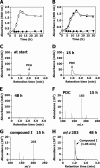Characterization of the protocatechuate 4,5-cleavage pathway operon in Comamonas sp. strain E6 and discovery of a novel pathway gene
- PMID: 20952641
- PMCID: PMC3008244
- DOI: 10.1128/AEM.01863-10
Characterization of the protocatechuate 4,5-cleavage pathway operon in Comamonas sp. strain E6 and discovery of a novel pathway gene
Abstract
The protocatechuate (PCA) 4,5-cleavage (PCA45) pathway is the essential catabolic route for the degradation of various aromatic acids in the genus Comamonas. All of the PCA45 pathway genes, orf1-pmdKEFDABC, as well as another PCA 4,5-dioxygenase gene, pmdA(II)B(II), were isolated from a phthalate-degrading bacterium, Comamonas sp. strain E6. Disruption of pmdB and pmdD in E6, which code for the β subunit of PCA 4,5-dioxygenase and 2-pyrone-4,6-dicarboxylate (PDC) hydrolase, respectively, resulted in a growth defect on PCA, indicating that these genes are essential for the growth of E6 on PCA. On the other hand, inactivation of pmdB(II) did not affect the growth of E6 on PCA. Disruption of pmdK, which is related to a 4-hydroxybenzoate/PCA transporter of Pseudomonas putida, resulted in growth retardation on PCA. The insertional inactivation of orf1 in E6, whose deduced amino acid sequence has no similarity with proteins of known function, led to the complete loss of growth on PCA and the accumulation of PDC and 4-oxalomesaconate (OMA) from PCA. These results indicated the involvement of orf1 in the PCA45 pathway, and this gene, designated pmdU, was suggested to code for OMA tautomerase. Reverse transcription-PCR analysis suggested that the pmdUKEFDABC genes constitute an operon. The transcription start site of the pmd operon was mapped at 167 nucleotides upstream of the initiation codon of pmdU. The pmd promoter activity was enhanced 20-fold when the cells were grown in the presence of PCA. Inducers of the pmd operon were found to be PCA and PDC, but PDC was the more effective inducer.
Figures






Similar articles
-
Characterization of the isophthalate degradation genes of Comamonas sp. strain E6.Appl Environ Microbiol. 2010 Jan;76(2):519-27. doi: 10.1128/AEM.01270-09. Epub 2009 Nov 20. Appl Environ Microbiol. 2010. PMID: 19933340 Free PMC article.
-
Assimilation of aromatic compounds by Comamonas testosteroni: characterization and spreadability of protocatechuate 4,5-cleavage pathway in bacteria.Appl Microbiol Biotechnol. 2013 Jul;97(13):6031-41. doi: 10.1007/s00253-012-4402-8. Epub 2012 Sep 21. Appl Microbiol Biotechnol. 2013. PMID: 22996279
-
Characterization of the terephthalate degradation genes of Comamonas sp. strain E6.Appl Environ Microbiol. 2006 Mar;72(3):1825-32. doi: 10.1128/AEM.72.3.1825-1832.2006. Appl Environ Microbiol. 2006. PMID: 16517628 Free PMC article.
-
Characterization of the 4-carboxy-4-hydroxy-2-oxoadipate aldolase gene and operon structure of the protocatechuate 4,5-cleavage pathway genes in Sphingomonas paucimobilis SYK-6.J Bacteriol. 2003 Jan;185(1):41-50. doi: 10.1128/JB.185.1.41-50.2003. J Bacteriol. 2003. PMID: 12486039 Free PMC article.
-
Transcriptional regulation of the terephthalate catabolism operon in Comamonas sp. strain E6.Appl Environ Microbiol. 2010 Sep;76(18):6047-55. doi: 10.1128/AEM.00742-10. Epub 2010 Jul 23. Appl Environ Microbiol. 2010. PMID: 20656871 Free PMC article.
Cited by
-
High correlation between genotypes and phenotypes of environmental bacteria Comamonas testosteroni strains.BMC Genomics. 2015 Feb 21;16(1):110. doi: 10.1186/s12864-015-1314-x. BMC Genomics. 2015. PMID: 25766446 Free PMC article.
-
Engineering Comamonas testosteroni for the production of 2-pyrone-4,6-dicarboxylic acid as a promising building block.Microb Cell Fact. 2023 Sep 19;22(1):188. doi: 10.1186/s12934-023-02202-2. Microb Cell Fact. 2023. PMID: 37726725 Free PMC article.
-
Influence of dairy by-product waste milk on the microbiomes of different gastrointestinal tract components in pre-weaned dairy calves.Sci Rep. 2017 Mar 10;7:42689. doi: 10.1038/srep42689. Sci Rep. 2017. PMID: 28281639 Free PMC article.
-
Structural and Kinetic Characterization of the 4-Carboxy-2-hydroxymuconate Hydratase from the Gallate and Protocatechuate 4,5-Cleavage Pathways of Pseudomonas putida KT2440.J Biol Chem. 2016 Apr 1;291(14):7669-86. doi: 10.1074/jbc.M115.682054. Epub 2016 Feb 11. J Biol Chem. 2016. PMID: 26867578 Free PMC article.
-
The major facilitator superfamily (MFS) revisited.FEBS J. 2012 Jun;279(11):2022-35. doi: 10.1111/j.1742-4658.2012.08588.x. Epub 2012 May 8. FEBS J. 2012. PMID: 22458847 Free PMC article.
References
-
- Bagdasarian, M., R. Lurz, B. Rückert, F. C. Franklin, M. M. Bagdasarian, J. Frey, and K. N. Timmis. 1981. Specific-purpose plasmid cloning vectors II. Broad host range, high copy number, RSF1010-derived vectors, and a host-vector system for gene cloning in Pseudomonas. Gene 16:237-247. - PubMed
-
- Blatny, J. M., T. Brautaset, H. C. Winther-Larsen, P. Karunakaran, and S. Valla. 1997. Improved broad-host-range RK2 vectors useful for high and low regulated gene expression levels in gram-negative bacteria. Plasmid 38:35-51. - PubMed
-
- Bolivar, F., and K. Backman. 1979. Plasmids of Escherichia coli as cloning vectors. Methods Enzymol. 68:245-267. - PubMed
Publication types
MeSH terms
Substances
Associated data
- Actions
- Actions
LinkOut - more resources
Full Text Sources
Molecular Biology Databases

